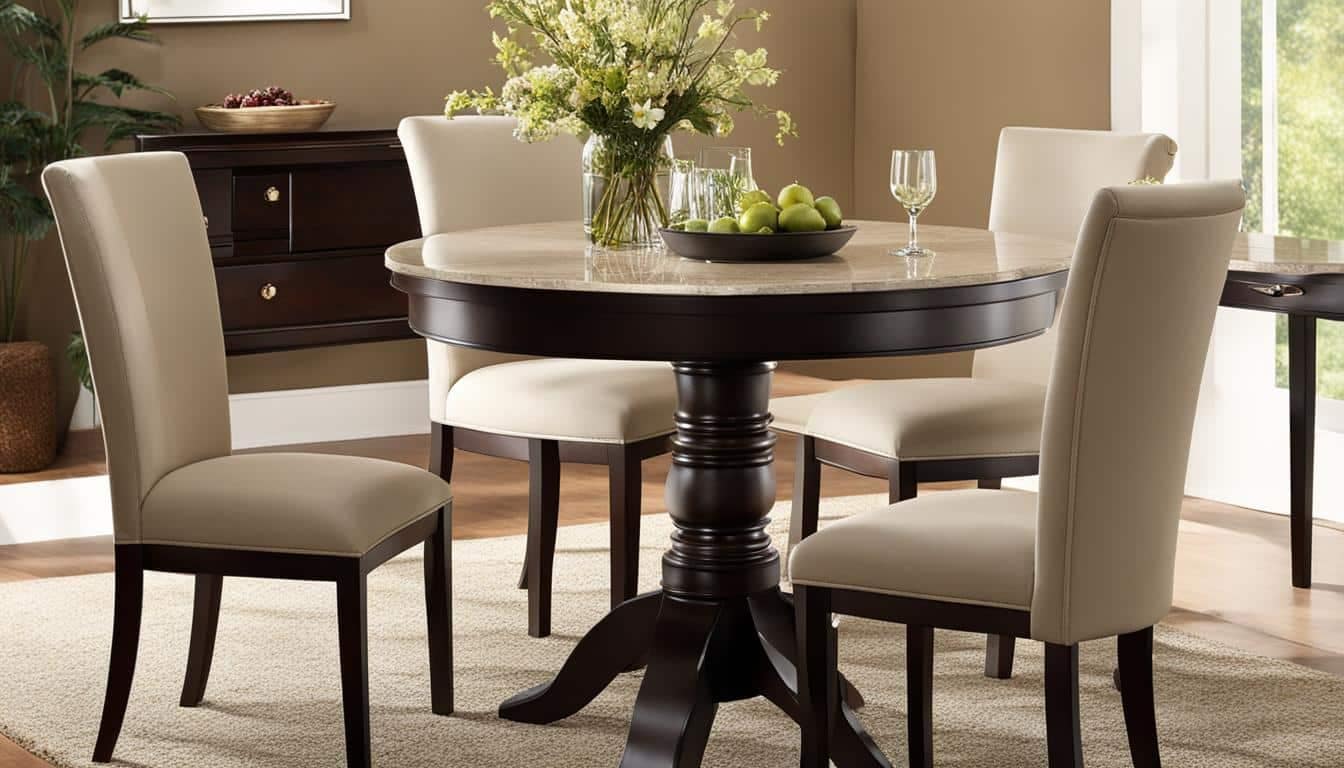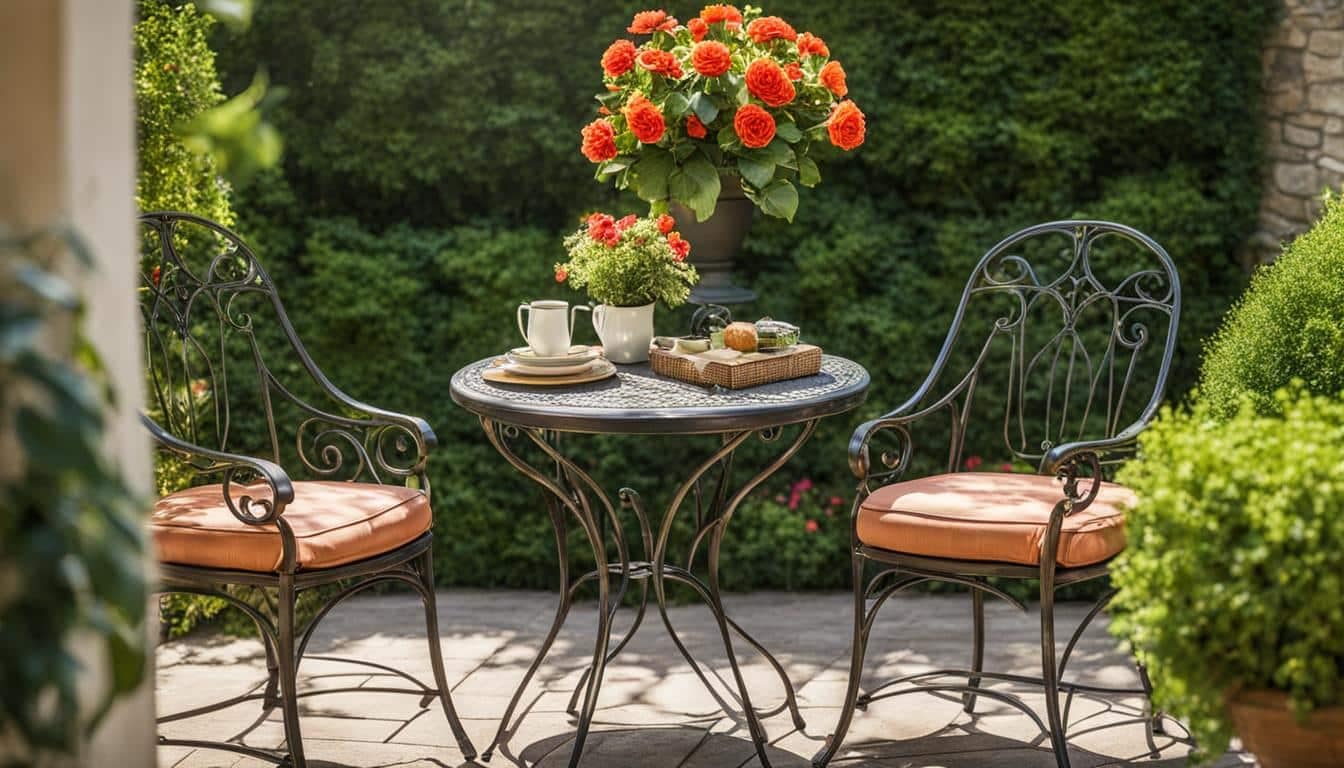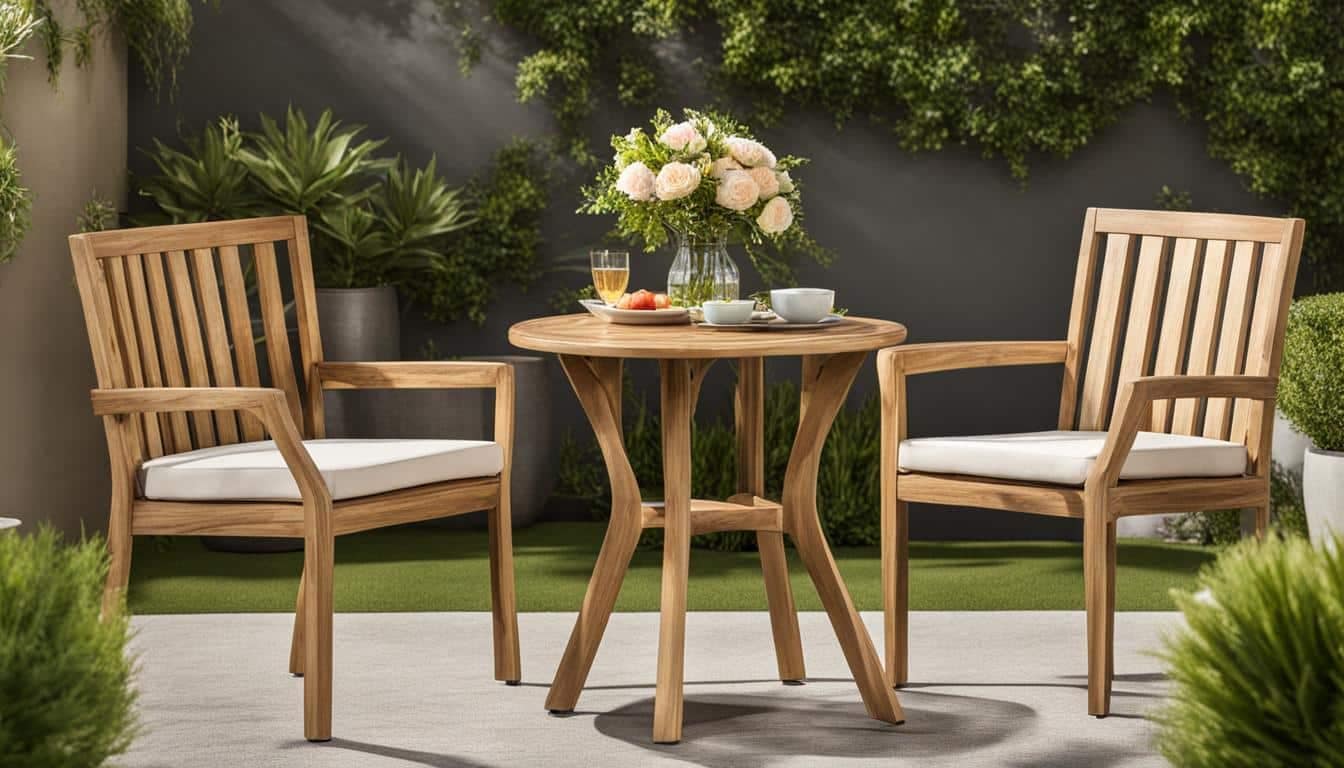Protecting your patio furniture during the winter is essential to ensure its longevity and keep it in good condition. By following these expert tips, you can effectively store your patio furniture and prevent unnecessary damage.
Key Takeaways:
- Properly preparing your furniture before winter storage is crucial.
- Choose a suitable storage spot that provides optimal protection.
- Cover your furniture with durable, waterproof covers to safeguard it from the elements.
- Store cushions and fabrics indoors to protect them from moisture and pests.
- Maintain your stored furniture throughout the winter to prevent potential damage.
Preparing Your Furniture for Winter Storage
Before storing your patio furniture for the winter, it’s important to properly prepare it. Follow these best practices to ensure your furniture remains in good condition:
- Clean your furniture: Begin by washing your furniture with a gentle soap and water solution to remove any dirt or stains. Pay attention to crevices and hard-to-reach areas. Rinse thoroughly and allow it to dry completely before storage.
- Protect fabric cushions: If your furniture has fabric cushions, consider investing in removable cushion covers that can be washed separately. This will help keep them clean and in good condition.
- Choose a suitable storage spot: Select a storage location that can protect your furniture from the elements. Ideally, bring your furniture indoors to a garage, shed, or storage unit. If indoor storage is not possible, find a covered area that provides some protection from rain, snow, and extreme temperatures.
- Cover your furniture properly: Once your furniture is clean and in its designated storage spot, cover it with a durable, waterproof cover. The cover should fit securely and have buckles or straps to prevent it from blowing off in strong winds.
By following these steps and taking the time to properly prepare your furniture for winter storage, you can ensure its longevity and protect it from unnecessary damage.
Choosing the Right Storage Spot
When it comes to protecting your outdoor furniture during the winter months, selecting the right storage spot is crucial. If you have the option, bringing your furniture indoors to a garage, shed, or storage unit is the best choice. This provides optimal protection from harsh weather conditions such as snow, ice, and freezing temperatures.
If indoor storage is not feasible, there are other winter storage solutions for patio furniture. Consider investing in durable covers specifically designed for outdoor furniture. These covers should be waterproof, fade-resistant, and have buckles or straps to secure them in place. Using high-quality covers will protect your furniture from moisture, UV rays, and debris.
Additionally, it’s important to choose a storage spot that is well-ventilated to prevent mold and mildew growth. Proper airflow will help keep your furniture dry and free from moisture damage. If your furniture is made of wood, avoid storing it in a damp or humid area as this can lead to warping and rot.
Benefits of Indoor Storage
Storing your outdoor furniture indoors during the winter offers several benefits. Firstly, it provides the highest level of protection against extreme weather conditions, prolonging the lifespan of your furniture. It also reduces the risk of damage from moisture, pests, and UV rays.
Indoor storage also allows for easier maintenance and cleaning. You can easily access your furniture to perform periodic checks and cleanings to ensure it remains in good condition. Additionally, storing your furniture indoors prevents it from becoming an eyesore in your outdoor space during the winter months.
Choosing Covers for Outdoor Storage
| Cover Type | Features |
|---|---|
| Waterproof Covers | Effectively repel water and prevent damage from rain, snow, and ice. |
| Fade-Resistant Covers | Protect against sun damage and maintain the aesthetics of your furniture. |
| Secure Straps and Buckles | Ensure a snug fit to prevent the covers from blowing off in high winds. |
| Proper Ventilation | Allow for airflow to prevent moisture build-up and mold growth. |
When choosing covers for outdoor storage, look for options that are specifically designed for patio furniture. Consider the material, size, and shape of your furniture to ensure the covers fit properly. Investing in quality covers will provide reliable protection for your outdoor furniture throughout the winter season.
Safeguarding Your Patio Furniture During Winter: Properly Covering Your Furniture
As you prepare to store your patio furniture for the winter, proper covering is essential to protect it from the harsh elements. By choosing the right covers and implementing the correct techniques, you can safeguard your furniture and ensure its longevity. Here are some important tips for properly covering your patio furniture during winter storage.
Choosing Durable and Waterproof Covers
When selecting covers for your patio furniture, opt for ones that are durable, waterproof, and fade-resistant. These qualities are crucial to withstand the winter conditions and protect your furniture from snow, rain, and UV rays. Look for covers with sloped angles, which allow snow and debris to slide off easily and prevent accumulation. Additionally, make sure the covers have buckles and straps for a snug fit, preventing dirt and moisture from seeping in.
Promoting Proper Airflow with Dry Vents
To prevent moisture build-up and potential mildew growth, it’s important to choose covers with dry vents. Dry vents promote proper airflow, allowing moisture to escape and reducing the risk of damage. These vents also help in maintaining the overall condition of your furniture and preventing any unpleasant odors that may occur due to moisture accumulation.
Covering Specific Furniture Pieces Individually
Each furniture piece may have different requirements for covering. For example, if you have a dining set, it’s advisable to cover each chair and table individually to ensure maximum protection. By covering each piece separately, you can prevent damage caused by moisture, scratches, or other potential hazards. Consider grouping smaller items together, such as cushions, and storing them in separate covers or containers.
| Furniture Material | Recommended Covering Technique |
|---|---|
| Wood | Apply a protective wood sealer or protector before covering. |
| Wrought Iron | Remove rust or stains and cover with a waterproof cover. |
| Aluminum/Steel | Simply cover with a waterproof and fade-resistant cover. |
| Plastic | Wipe down with a mild soap and water solution before covering. |
By following these tips, you can effectively cover your patio furniture during winter storage and provide the necessary protection. Remember to choose durable, waterproof covers, promote proper airflow with dry vents, and cover each furniture piece individually. Safeguarding your furniture ensures it will be in excellent condition when warmer weather returns, allowing you to enjoy outdoor gatherings and relaxation without any worries.
Storing Cushions and Fabrics
When it comes to winter care for patio furniture, don’t forget about your cushions and fabrics. Properly storing them during the winter months will help maintain their quality and prolong their lifespan. Follow these steps to ensure your cushions and fabrics are protected:
Step 1: Remove and Clean
First, remove all the cushions from your patio furniture. Check the manufacturer’s instructions for specific cleaning recommendations. In general, most outdoor cushions can be cleaned by wiping them down with a mild soap and water solution. For tougher stains, use a fabric cleaner or stain remover as directed. Allow the cushions to dry completely before moving on to the next step.
Step 2: Store Indoors
It’s best to store your cushions and fabrics indoors during the winter. Find a dry area in your home, such as a basement or a closet, where they will be protected from moisture and extreme temperature fluctuations. If you don’t have enough space indoors, consider using vacuum-seal storage bags to minimize their size and protect them from pests. Make sure to label the bags for easy retrieval in the spring.
Step 3: Avoid Plastic Bags
While it may be tempting to store your cushions and fabrics in plastic bags, it’s important to avoid doing so. Plastic bags can trap moisture, leading to mold and mildew growth. Instead, opt for breathable storage boxes or fabric covers. These will allow air to circulate while still protecting your cushions and fabrics from dust and dirt.
Step 4: Protect from Pests
Pests like rodents and insects can cause damage to your cushions and fabrics. To protect against this, consider adding cedar chips or mothballs to your storage area. These natural repellents can help deter unwanted guests from making a cozy home in your cushions.
By following these steps to store your cushions and fabrics properly, you can ensure they will be in great condition when it’s time to use them again in the spring. Taking care of all aspects of your patio furniture during the winter months will help prolong its lifespan and ensure you can enjoy it for many years to come.
| Step | Description |
|---|---|
| Step 1 | Remove and clean the cushions |
| Step 2 | Store the cushions indoors |
| Step 3 | Avoid plastic bags for storage |
| Step 4 | Protect from pests |
Maintaining Your Stored Furniture
Proper maintenance of your stored patio furniture during the winter months is essential to ensure its longevity and protect it from potential damage. By taking a few simple steps, you can keep your furniture in good condition and ready to be enjoyed when the warmer weather returns. Here are some winter storage tips for your patio furniture:
Regular Check-Ups
Throughout the winter, it’s important to periodically check on your stored furniture to prevent any issues from escalating. Inspect for any signs of moisture build-up, mold, or pest infestation. If you notice any problems, take immediate action to address them. This may involve airing out the storage area, applying anti-mold solutions, or using pest repellents to safeguard your furniture.
Airflow and Ventilation
Ensure that there is proper airflow and ventilation in the storage area to prevent moisture accumulation. This can be achieved by leaving some space between your furniture and the walls, allowing air to circulate freely. Consider using moisture-absorbing products like dehumidifiers or silica gel packets to maintain optimal humidity levels and keep your furniture dry.
Protective Covers
To further safeguard your furniture, use high-quality covers that are designed specifically for outdoor use. These covers should be waterproof, fade-resistant, and feature buckles or straps to secure them tightly. Choose covers with sloped angles to allow for easy snow and debris removal. Additionally, opt for covers with dry vents to promote proper airflow and prevent moisture from accumulating, which can lead to mold or mildew.
| Furniture Maintenance Tips |
|---|
| Regularly inspect furniture for any signs of moisture, mold, or pests |
| Ensure proper airflow and ventilation in the storage area |
| Use high-quality waterproof and fade-resistant covers |
| Choose covers with dry vents to promote airflow |
By following these winter storage tips for your patio furniture, you can maintain its quality and protect it from the harsh winter elements. Regular check-ups, proper ventilation, and the use of protective covers are key to ensuring that your furniture stays in excellent condition throughout the colder months. With a little care and attention, you can extend the lifespan of your patio furniture and enjoy many more seasons of outdoor relaxation and entertainment.
Winterizing Different Types of Materials
When it comes to preparing your patio furniture for winter storage, different materials require specific care and attention. Here are some best practices for winterizing different types of materials:
Teak Furniture
Teak is a popular choice for outdoor furniture due to its durability and natural resistance to rot and insects. To winterize your teak furniture, start by cleaning it with a recommended teak cleaner to remove any dirt or stains. After cleaning, apply teak oil to restore its natural color and provide an additional layer of protection against the harsh winter elements.
Aluminum and Steel Furniture
Aluminum and steel furniture are known for their lightweight and low-maintenance qualities. To winterize these types of furniture, simply clean them with a hose and a gentle soap solution to remove any dirt or debris. Once cleaned, ensure they are completely dry before storing them to prevent rust or corrosion.
Plastic Furniture
Plastic furniture is a popular and affordable option for outdoor use. To winterize your plastic furniture, wipe it down with a mild soap and water solution to remove any dirt or stains. Ensure it is dry before storing it in a covered area or using weatherproof covers to protect it from the elements.
Wood Furniture
Wood furniture requires extra care during the winter months to prevent damage from moisture and cold temperatures. Follow the specific cleaning instructions provided by the manufacturer to clean your wood furniture. Consider applying a wood sealer or protector to provide an extra layer of defense against the winter weather.
| Material | Winterization Steps |
|---|---|
| Teak Furniture | Clean with teak cleaner and apply teak oil |
| Aluminum and Steel Furniture | Clean with gentle soap and water, ensure it is dry |
| Plastic Furniture | Wipe down with mild soap and water, store in a covered area or use weatherproof covers |
| Wood Furniture | Follow manufacturer’s cleaning instructions, consider applying a wood sealer or protector |
By taking the time to properly winterize your patio furniture based on its material, you can ensure that it stays in good condition and lasts for many seasons to come.
Alternatives to Indoor Storage
If you don’t have the option to bring your patio furniture indoors for winter storage, there are still alternative solutions to protect it from the harsh elements. Consider using weatherproof covers or tarps specifically designed for outdoor furniture. These covers should be durable, waterproof, and fade-resistant to provide optimal protection.
When using covers, it is important to secure them tightly to prevent wind from blowing them off. You can use bungee cords or rope to cinch the bottom for added protection. This will ensure that your furniture stays securely covered throughout the winter months. Additionally, look for covers with sloped angles to allow snow and debris to slide off easily.
If you opt for using tarps, make sure they are made of heavy-duty plastic and offer proper ventilation to prevent mold and mildew. Tarps can be an affordable choice for protecting your outdoor furniture, but ensure that they are securely fastened and provide adequate airflow to avoid any potential damage.
The Benefits of Proper Winter Storage
Properly storing your patio furniture during the winter offers numerous benefits. By following the recommended steps, you can extend the lifespan of your furniture, maintain its aesthetic appeal, and prevent costly damage. Investing time and effort into winter storage will ensure that your patio furniture remains in good condition and can be enjoyed for many more seasons to come.
Extended Lifespan
By properly storing your patio furniture in winter, you can significantly extend its lifespan. Harsh weather conditions, such as freezing temperatures and snow, can cause damage to furniture made from materials like wood, metal, or fabric. However, by storing your furniture indoors or using durable covers, you protect it from these elements and prevent premature wear and tear. This means you’ll be able to enjoy your patio furniture for many more years without having to replace it.
Maintained Aesthetic Appeal
Storing your patio furniture properly during the winter helps to maintain its aesthetic appeal. Protecting furniture from exposure to the elements prevents fading, discoloration, and other forms of damage that can affect its appearance. By keeping your furniture in good condition, you can ensure it looks its best when it’s time to bring it out again for the warmer seasons. Whether you have vibrant colored cushions, stylish designs, or elegant finishes, proper winter storage helps preserve the visual appeal of your patio furniture.
Prevention of Costly Damage
Perhaps one of the most significant benefits of proper winter storage is the prevention of costly damage. Leaving patio furniture unprotected during the winter months can lead to issues such as rust, mold, mildew, and structural damage. Repairing or replacing damaged furniture can be expensive and time-consuming. By taking the necessary steps to clean, cover, and store your furniture, you can avoid these potential problems and save yourself from unnecessary expenses.
Overall, proper winter storage for your patio furniture is essential for its longevity and continued enjoyment. By following expert tips and investing some time into preparation, you can protect your furniture from the winter elements, extend its lifespan, and maintain its aesthetic appeal. So before the winter arrives, make sure to take the necessary steps to store your patio furniture properly and enjoy the benefits for years to come.
Conclusion
Protecting and storing your patio furniture properly during the winter is essential for its longevity and continued enjoyment. By following the expert tips provided, you can ensure that your furniture remains in pristine condition, ready to be used again when the warmer weather returns. Take the necessary steps to clean, cover, and store your furniture, and enjoy the peace of mind knowing that it is protected throughout the winter months.
FAQ
How should I prepare my patio furniture for winter storage?
Clean your furniture with a gentle soap and water solution, and consider investing in removable cushion covers for fabric cushions.
Where should I store my patio furniture during the winter?
If possible, bring your furniture indoors to a garage, shed, or storage unit. If indoor storage is not feasible, invest in durable covers designed for outdoor furniture.
What should I look for in a patio furniture cover?
Choose covers that are durable, waterproof, fade-resistant, and have buckles or straps for a snug fit. Look for covers with sloped angles and dry vents for proper airflow.
How should I store my cushions and fabrics during the winter?
Remove the cushions, clean them according to the manufacturer’s instructions, and store them indoors in boxes or plastic bags. Consider vacuum-sealing them for extra protection.
How frequently should I check on my stored furniture during the winter?
Periodically check for moisture build-up, mold, or pest infestation. Take necessary actions to address any issues immediately.
How should I winterize different types of patio furniture materials?
Use recommended cleaners and oils for teak furniture, clean aluminum and steel furniture with a hose and gentle soap, wipe down plastic furniture with a mild soap and water solution, and follow specific cleaning instructions for wood and wrought iron furniture.
What alternatives do I have for indoor storage?
Consider using weatherproof covers or tarps to protect your outdoor furniture. Secure the covers tightly and ensure the tarps provide ventilation to prevent mold and mildew.
What are the benefits of properly storing patio furniture during the winter?
Proper winter storage extends the lifespan of your furniture, maintains its aesthetic appeal, and prevents costly damage.







